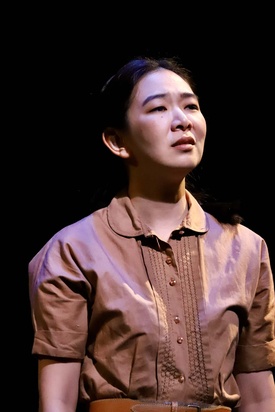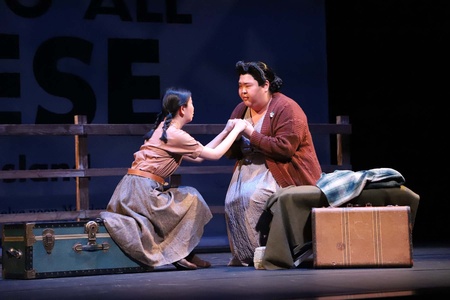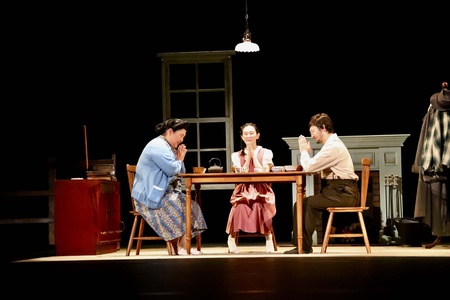There are as many ways to tell a story as there are stories. Historians, novelists, and artists of every conceivable medium have all chronicled the unjust internment of Japanese Americans during WWII. But an opera?
Turns out, opera has always been the perfect medium to capture the emotions of highly charged dramatic events. Hawai‘i Opera Theatre’s recent production of An American Dream demonstrated exactly that. With exceptional performances, costumes and set designs, this modern opera captured the anguish and difficult choices demanded of families during wartime but also their strength and resilience.
An American Dream tells the story of the Kobayashi family, forced to burn treasured possessions—except for a Hina Matsuri doll secretly hidden by daughter Setsuko—and sell their home to Jim Crowley, a WWI veteran and his German Jewish wife, Eva. According to librettist Jessica Murphy Moo, the opera started as a community storytelling project in Seattle that posed the question: what is your most precious possession and why? Two of the responses inspired the opera’s pivotal characters of Setsuko Kobayashi and Eva Crowley who each lose what they most cherished.
Moo wrote the libretto in collaboration with composer Jack Perla. An American Dream debuted in 2015, performed by Seattle Opera. “An American Dream asks us to confront the parallels between past and present and engage in dialogue around fear, othering and political messaging,” wrote Perla. That makes this opera more relevant than ever—a powerful way to preserve the past, inform the present and influence the future.
Megan Leung is Director of Marketing and Communications for Hawai‘i Opera Theatre (HOT). She worked with HOT’s Artistic Director, Jamie Offenbach to answer questions about Hawai‘i Opera Theatre’s production of An American Dream.
* * * * *
Can you tell me how the Hawai‘i Opera Theatre chose An American Dream for its 23/24 season?
When choosing An American Dream for our 23/24 Season, we considered a number of elements, one primarily being that we wanted a story that would resonate with our audience here in Hawai‘i. An American Dream offered an amazing opportunity to tell a story about Japanese American incarceration that is relevant here, but also explores universal themes of loss, tragedy, and hope. Inclusivity in our casting was also a key driver for us in choosing this opera. We wanted to include an opera that allowed us to reflect the community we live in, cast locally, and felt that An American Dream provided us the perfect opportunity to do so.
Additionally, we've been passionate about tackling some of the common misconceptions and stereotypes surrounding opera. People often think it's too long, difficult to understand, or disconnected, but An American Dream was a 65-minute-long opera sung in English. It was the perfect way to show people that opera is fresh and accessible. It fits perfectly into our season, as we’ve also been aiming to broaden our overall repertoire to include more contemporary and shorter works.
How has this opera production been received by the local audience?
The opera was received well—our attendees really enjoyed how strongly the story resonated with them and appreciated how works like these aid in preserving historical moments that can so easily be lost. It provided a lot of room for conversation. A lot of our longtime supporters also enjoyed this opera.
Some quotes right from our attendees:
“Love that HOT is sharing this important story, amazing production and leveraging of resources. Operas such as this, no intermission, shorter, relevant and timely theme, Asian performers will bring in more audiences.”
“The story was moving, and the musical talents of the performers were superb! The musical accompaniment, led by guest conductor maestro Lance Inouye, was precise and immensely and emotionally stirring!”
“An American Dream was an outstanding, modern, opera with great significance for Hawai‘i. It was beautifully presented, the music was lovely, and the story heartbreaking. It was everything a good opera should be.”
Hawai‘i Opera Theatre offered performances of An American Dream in three venues across Oahu. The temporary closing of Honolulu’s Blaisdell Concert Hall certainly provided an opportunity to make opera more accessible around the island. But did the subject matter of An American Dream, which certainly resonates with so many Japanese American residents living in Hawai‘i also play a part in the decision?
Absolutely—we thought this was such an important story to tell and we really wanted to give our audiences as many chances as possible to catch this production. The Blaisdell closing was a challenge at first, but it also really opened an opportunity for us to make opera more accessible and be in communities that have never experienced opera previously.
The performance included several locals. How did the production come together?
Whenever possible, we make it a point to include local performers in all our productions. We always look to celebrate and support the incredible talent we have right here in Hawai‘i. For all of our performances at STUDIO101 (our intimate performance space at Hawai‘i Opera Plaza), we feature all local artists. Our education programs (Mae Z. Orvis Studio & Orvis Young Voices Program) play a crucial role in finding, fostering, and casting local talent as well. These programs help us discover new, young singers, and we absolutely love working closely with them and seeing their growth. Robert Ellsworth Feng, Bass, who starred as Papa Kobayashi, used to be in our Orvis Young Voices program!
Are you aware of any personal connections to internment camps or concentration camps with the performers, Hawai‘i Opera Theatre staff, board members or supporters?
Yes! One of our Board Members, Dan Nishikawa, comes to mind—both of his parents were incarcerated. His father, George Nishikawa and his family were interned at Tule Lake, and his mother Yoshiko Nishikawa (Miyaoka) and her family were interned at Gila River. He joined our post-show talkback at our Moanalua shows to share some of their stories and his insight. He’s been a long-time supporter of HOT and serves on many other boards, in addition to being an executive producer for the Broadway production of Allegiance, which also explores the history of Japanese American incarceration.
President Barack Obama designated Honouliuli Internment Camp, located in west Oahu, as a National Monument in 2019. How did the staff at Honouliuli National Historic Site become involved?
For An American Dream, we knew immediately that we wanted to involve the Honouliuli National Historic Site—it only seemed fitting, and when we initially reached out to them about a possible collaboration, they were incredibly receptive and supportive. They created a beautiful, historical display for our lobby, and they also joined our post-show talkback sessions to share their knowledge and perspective.
In our commitment to honoring the story in our talkback, we also explored various other collaborations to ensure we had representation from a variety of perspectives and groups. We invited representatives from the Japanese Cultural Center of Hawai‘i, who were incredibly insightful. We also ended up touring the center and their exhibit with our cast, which made for some wonderful lasting memories!
We also partnered with Jewish Community Services of Hawai‘i in our talkback as well. They played a pivotal role in connecting us with knowledgeable historians, teachers, and authors who could dive into some of the struggles of the Jewish community during the same time. We’re honored that we were able to provide a way for these voices to share their stories. All these partnerships were vital in making An American Dream a success.
Jack Perla wrote, “Over eight years since its premiere, the opera has proven a touchstone, inviting audiences to share stories of exclusion, loss, home and healing. We hope it continues to illuminate the line between our past and present, expanding awareness of a dark chapter in our history and suggesting a brighter future.”
That’s the power of storytelling. That’s the power of An American Dream.
* * * * *
*Find out more about An American Dream and Hawai‘i Opera Theatre here.
© 2023 Esther Newman










